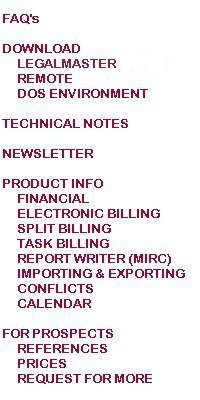


There are as many as three components to a Legalmaster installation.
First, you must ensure that you have an appropriate version of the file management software that we use, namely, Pervasive.SQL.
Once you have dealt with Pervasive, you install the Legalmaster application programs. This step is done only once, even if you are running Legalmaster on a network.
You must perform the third step once at each work-station (i.e., each computer) from which you intend to access Legalmaster.
Legalmaster uses file management software manufactured by a company called Pervasive. The software was called Btrieve until a few decades ago; in the late 1990's its name was changed to Pervasive; purchased by a company called Actian, the software was renamed to Actian Pervasive; beginning with version 14, it became Actian Zen. Legalmaster is compatible with any release of Btrieve/Pervasive/Actian Zen since version 6.15. Please read our Pervasive/Btrieve versions page if you want to learn more about your Pervasive options.
The gist of the matter is that you must ensure that you are running with a proper version of Pervasive before you install Legalmaster.
Before you install Pervasive, you must make sure that you are not already running a version of Pervasive for some other software application. If you are not sure, you can call CSP and we may be able to help you.
Legalmaster uses two folders. One stores our programs; the other, your data. If you plan to run Legalmaster on a network, both of these folders must be stored on your server. While you may name these folders pretty much anything you wish, here are our defaults.
Pick
a drive letter where you're going to store your Legalmaster
programs and data. Do not use UNC's (Universal Naming Convention);
use explicit
mapped drive letters.
Go
to the Download Host page on our website.
Read the instructions if you want.
III. Enabling A Work-station to Access Legalmaster
One of the files you downloaded in step #1 above is named LMINST.ZIP. Execute it with local admin rights at each workstation from which you want to be able to run Legalmaster. To execute LMINST with local administrative rights, you must copy LMINST.EXE to any folder on drive C of the workstation, right-click on it, and select run as administrator.
You'll be asked to provide just two paths; viz, the location of your Legalmaster program folder and the location of your Legalmaster data folder. Use the browser to locate these folders. Provide the full path in each case, for example, L:\LMW\LMWPROG. You may find that your browser fails to display the drive on which Legalmaster is stored; that's because, unless instructed otherwise, Microsoft Windows does not allow elevated programs -- that is, programs run with local administrative rights -- to see network drives.
Here's how you bypass this annoying Windows restriction. If you want, you may google -- we prefer duckduckgo -- "Elevated programs network drives." We have already done so, and this is one of the results we found and that has worked for almost all of our clients who've tried it. Once you've done this, rerun LMINST; you should now be able to browse to your network drives.
To
allow an elevated program, that is, a program run as administrator,
to see network drives
In
the registry go to
HKEY_LOCAL_MACHINE/Software/Microsoft/Windows/CurrentVersion/Policies/System
and
create a
DWORD
entry EnableLinkedConnections and assign it a value of 1
You'll
probably have to reboot the workstation for this change to take effect.
The
preceding step creates the Registry settings and INI files
that Legalmaster needs in order to run. Consequently, it is
important that you have the rights to modify your Registry. It
also should have created a shortcut to Legalmaster on your
desktop, but if it didn't, using Windows Explorer or My Computer,
whichever you prefer, open your LMWPROG folder and create a
shortcut to the file named LGLMAIN.EXE. Drag the shortcut to
your desktop and rename the shortcut Legalmaster.